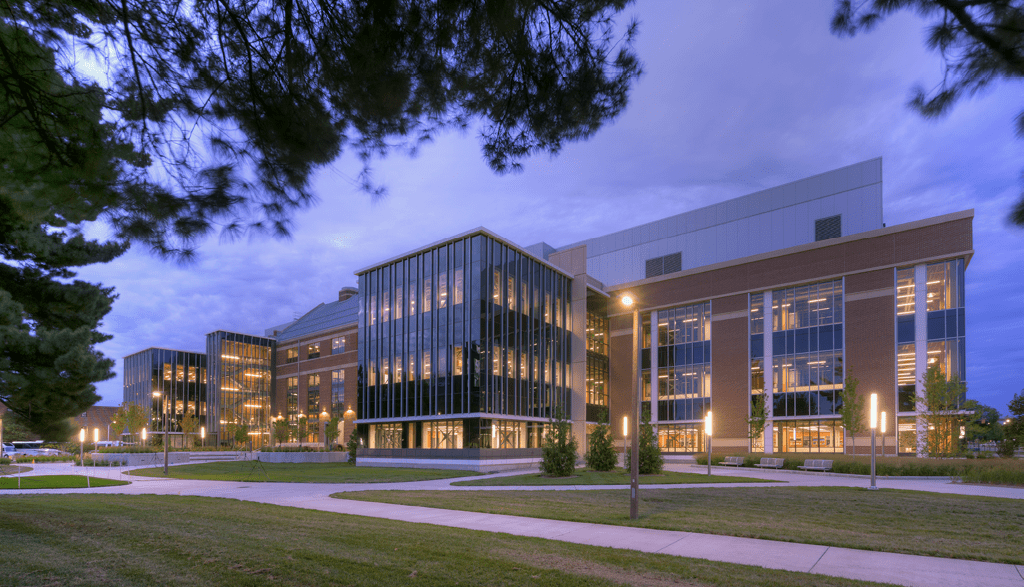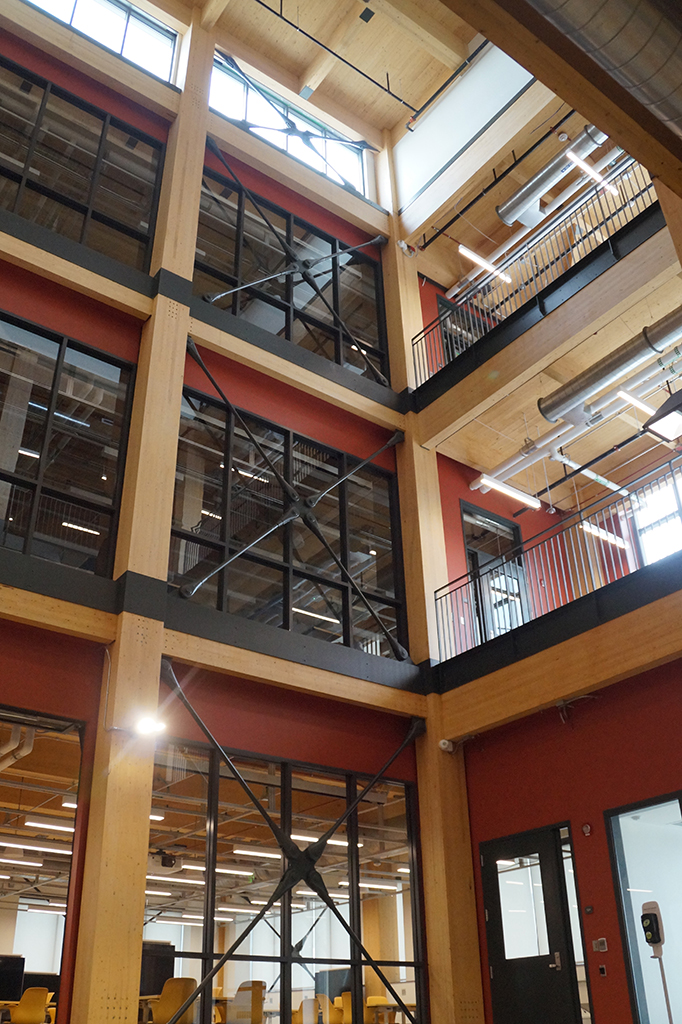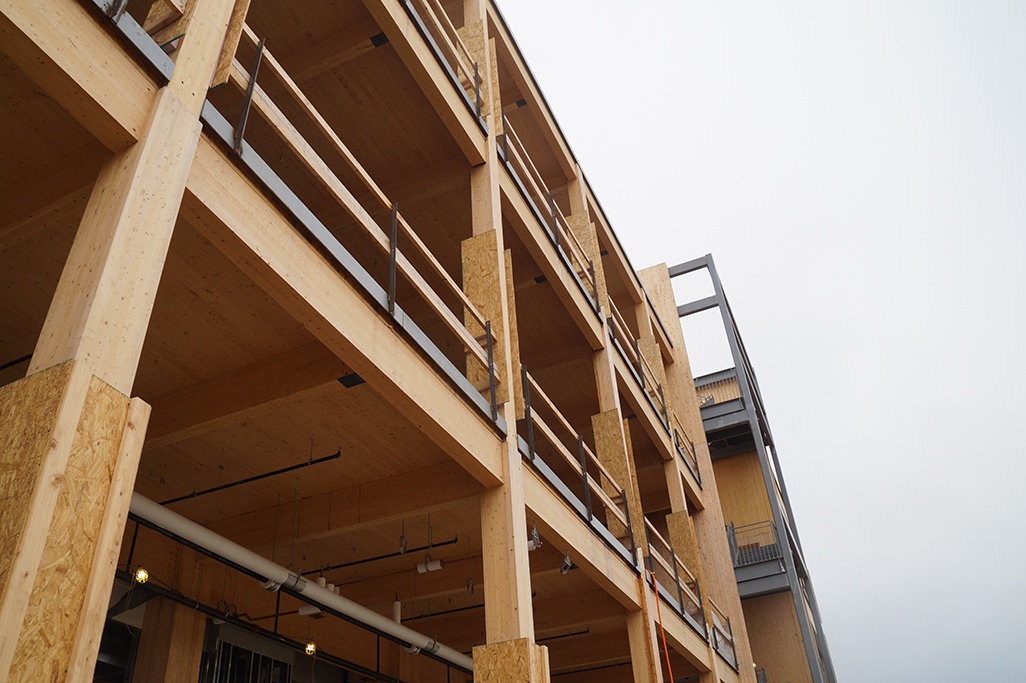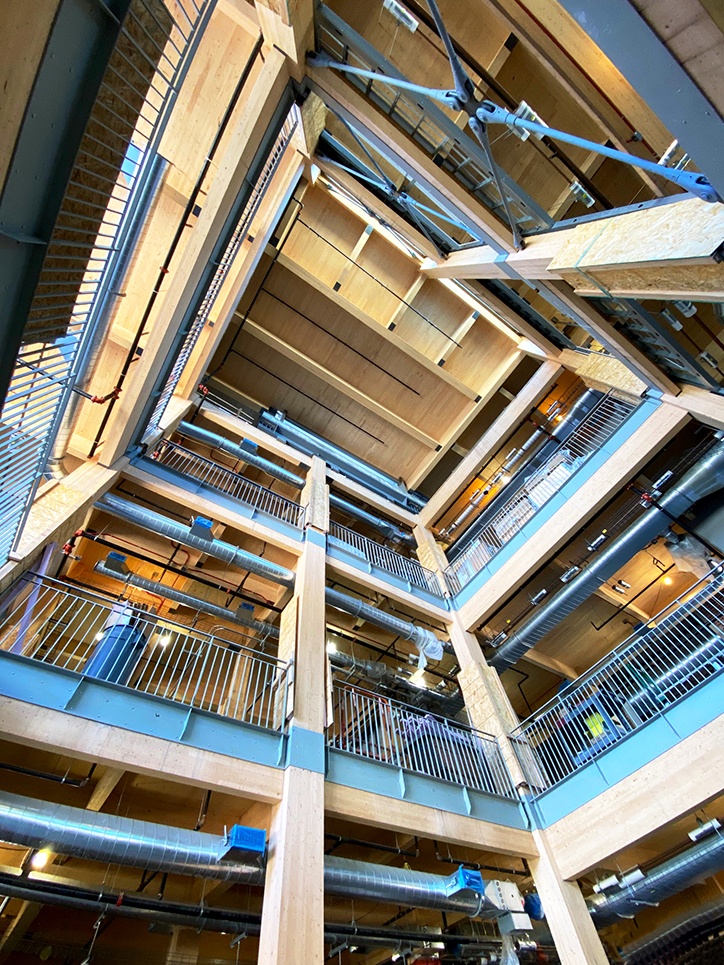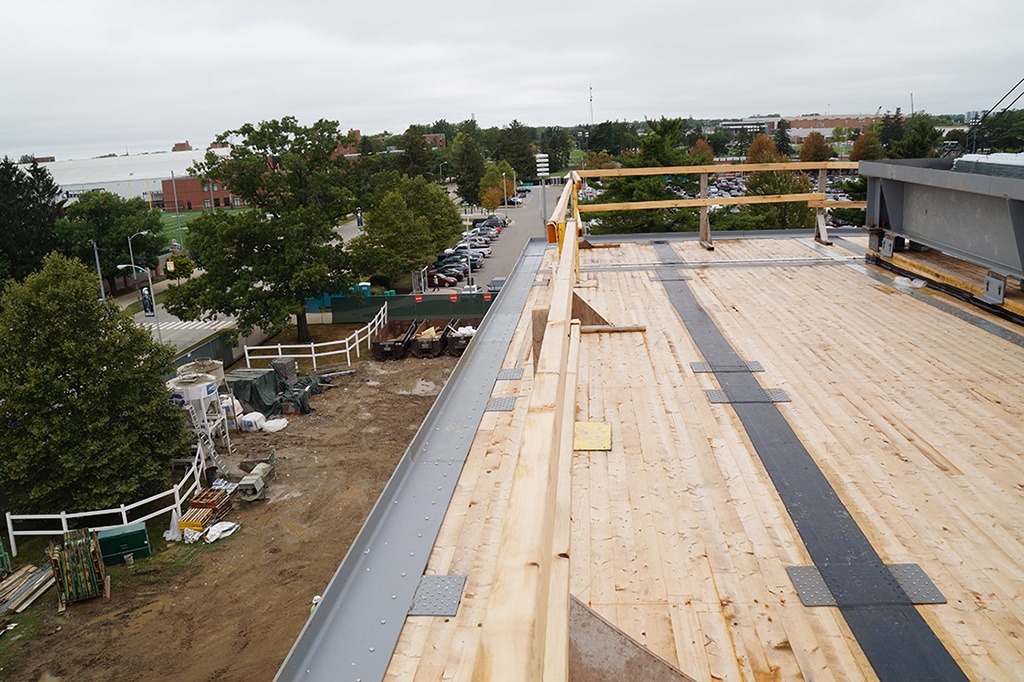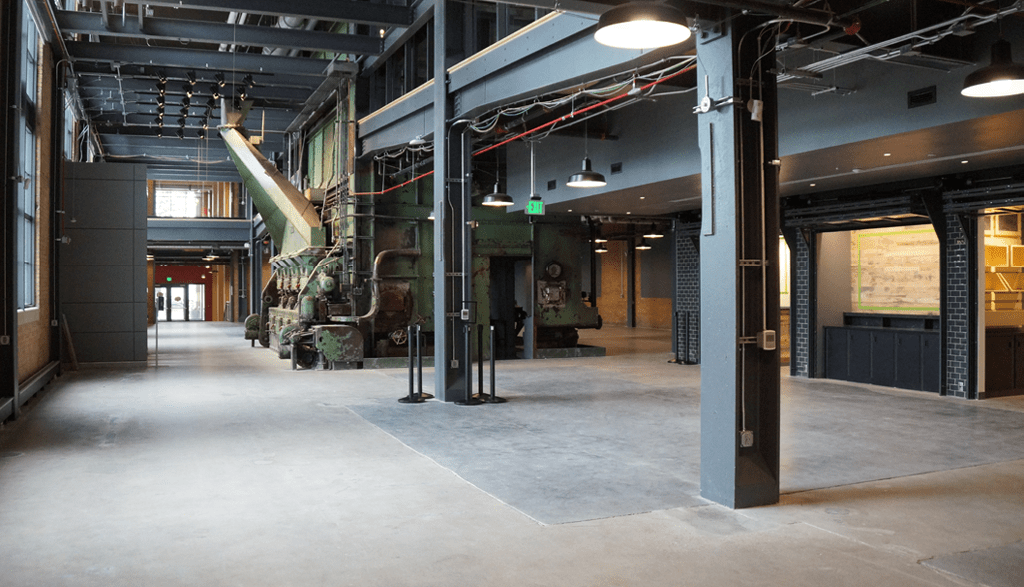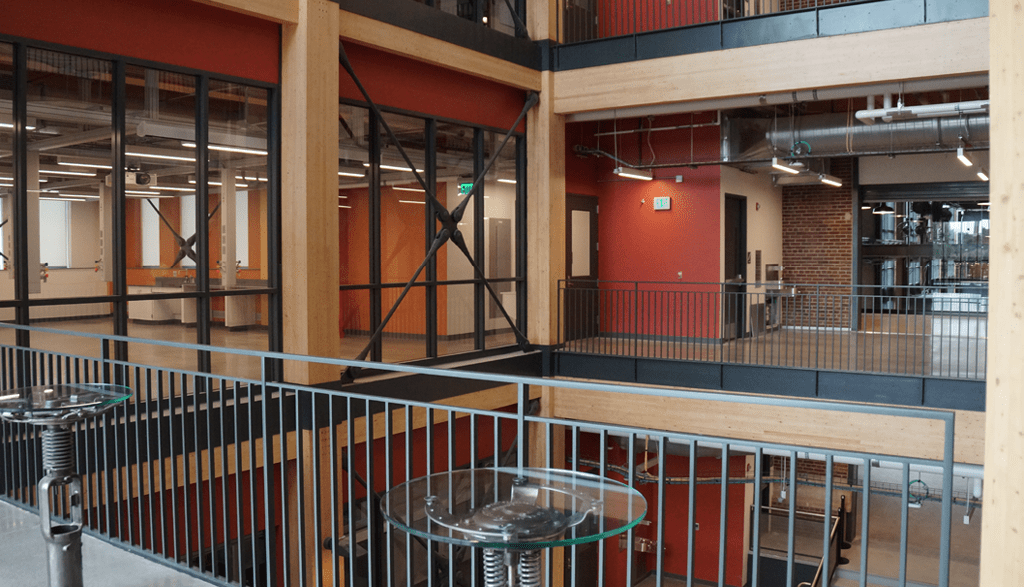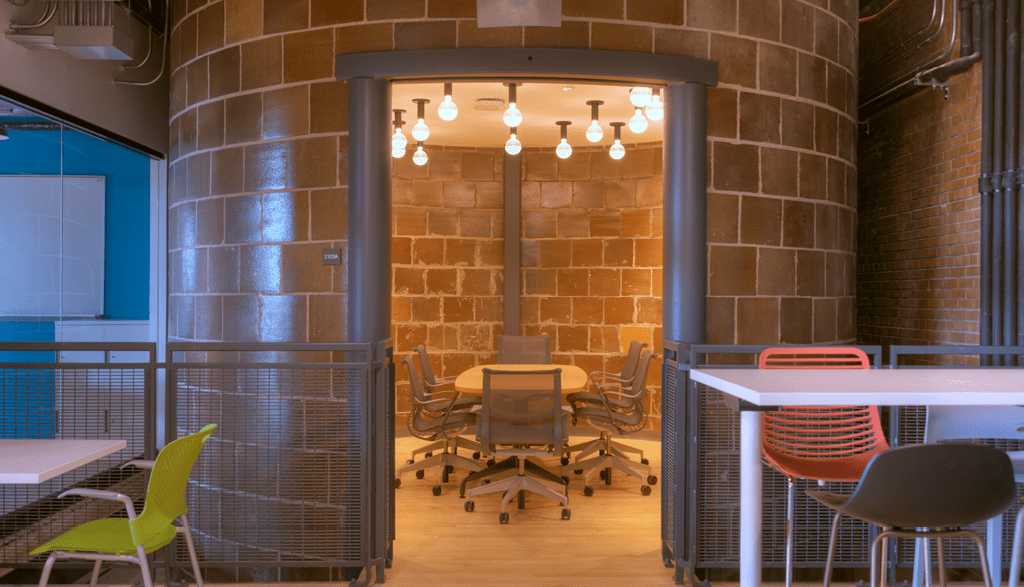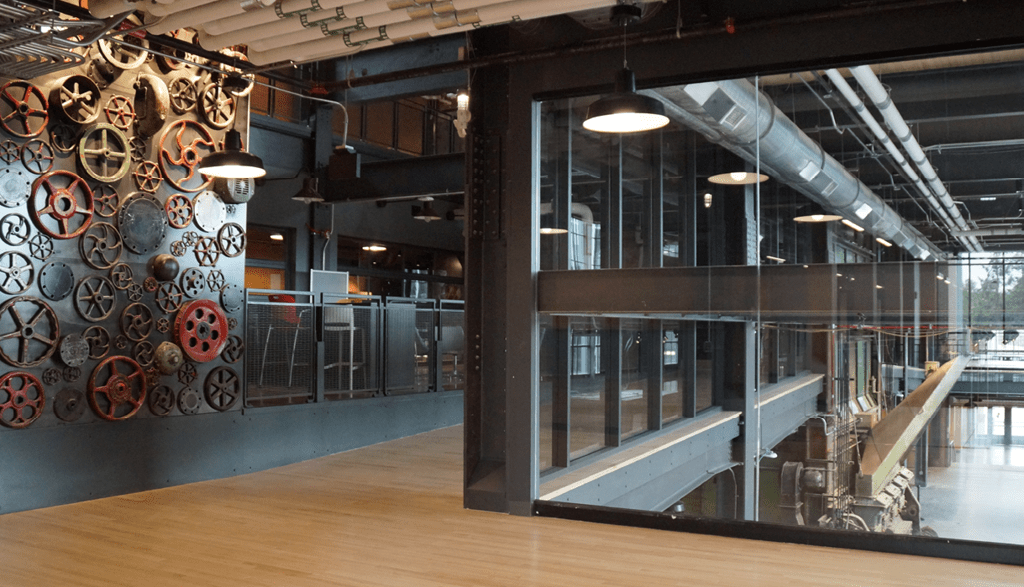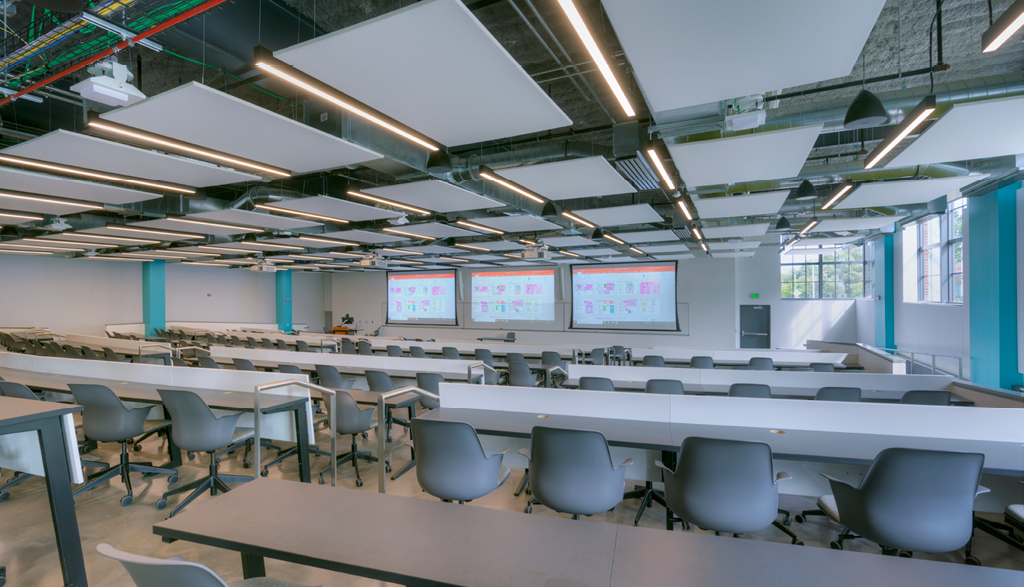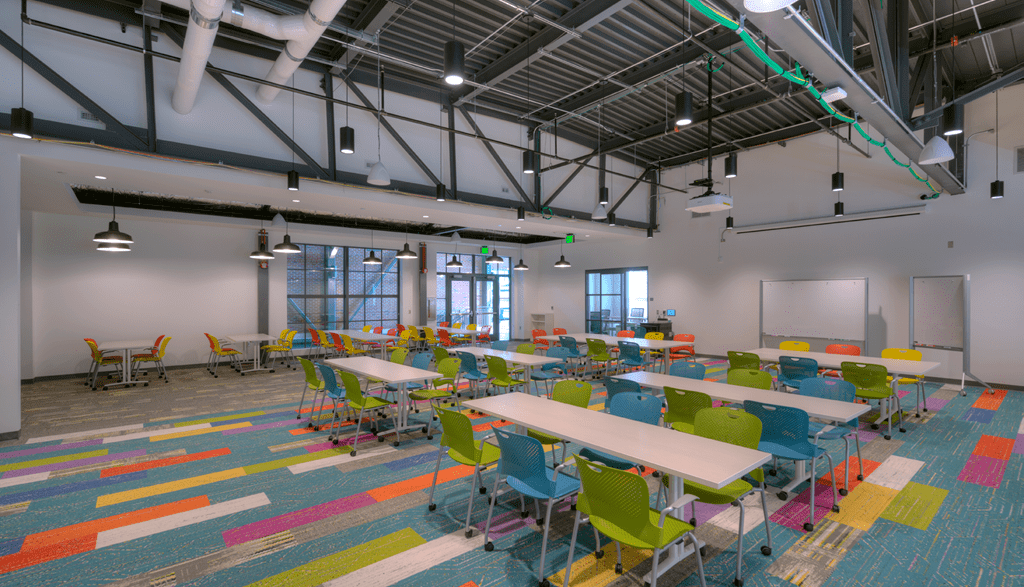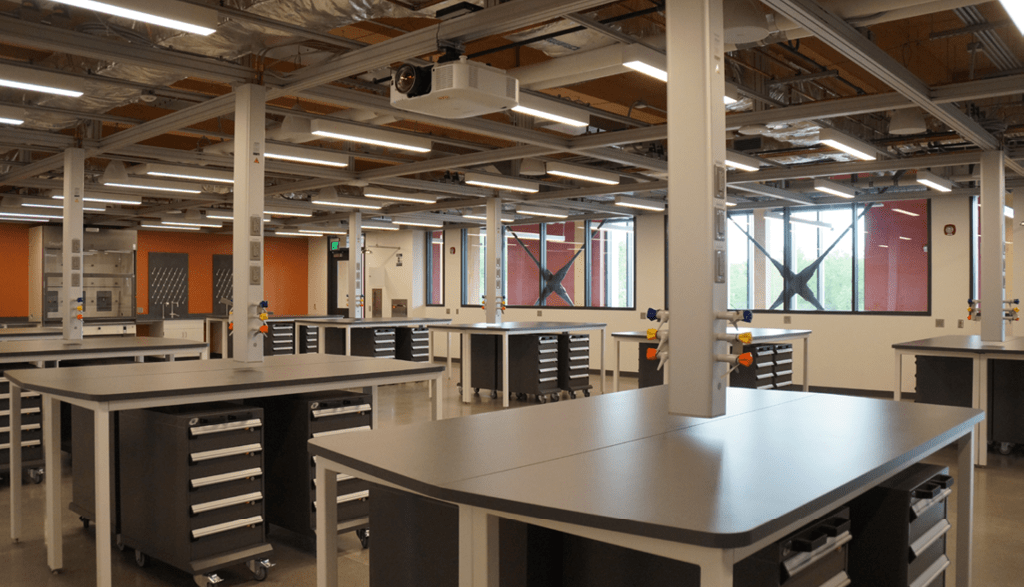What began as an overarching goal to improve and enhance the undergraduate learning experience at Michigan State University (MSU) has resulted in an historic victory with the 2021 completion of MSU’s STEM Teaching and Learning Facility and Shaw Lane Power Plant Renovation and Classroom Addition. Not only is MSU STEM the first building on campus, and the first in the state, constructed with a newer mass timber framing product called cross-laminated timber (CLT), the entire facility is situated on the site of MSU’s decommissioned Shaw Lane Power Plant (1948–1975), demonstrating an exemplary blend of adaptive reuse with state-of-the-art infrastructure for flexible learning.
Already, this project has received multiple awards, including a 2021 Engineering News-Record (ENR) Midwest Best Project Award of Merit, a 2021 Forest Stewardship Council (FSC) Leadership Award and a Construction Association of Michigan (CAM) Magazine Special Feature as one of Michigan’s 12 Most Outstanding Projects of 2021.
FACILITY OVERVIEW
Encompassing 120,000 square feet (SF) of new construction with 40,000 SF of renovated space, this project utilized the existing power plant as the central portion of the building, with large additions on the north and south sides. The completed building will allow the University to consolidate a number of teaching laboratories and classrooms which were formerly dispersed across campus, creating a central hub for STEM teaching and learning
Program goals for this project included:
- Improve and enhance MSU’s undergraduate learning experience, support experiential teaching and learning, attract and retain more students in STEM disciplines and better prepare these students for professional careers in fields of science, technology, engineering and math.
- Bring together dispersed and outdated teaching laboratories and related instructional support spaces; support changes in curriculum and teaching methods associated with STEM.
- Create a campus hub for teaching and learning across the sciences, arts and humanities.
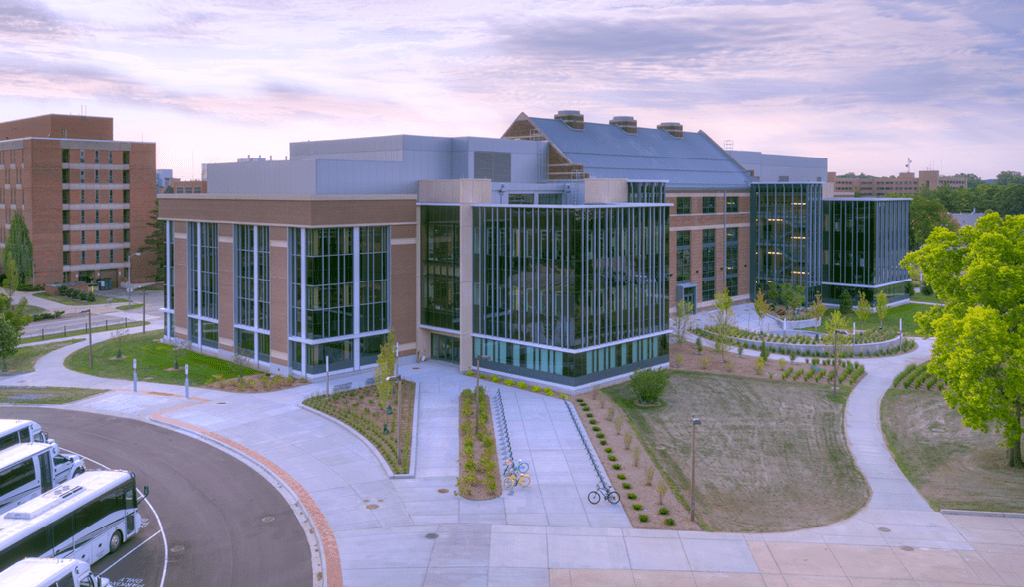
WORKING WITH CLT MASS TIMBER
By choosing to use CLT mass timber materials, the project team ensured MSU STEM would offer best-in-class features in terms of fire resistance, sustainability, efficiency and strength. However, implementing CLT on such a complex project, and as the first facility in the state, brought with it many challenges. Things the team needed to consider included limited regional material vendors as well as more difficult installation, handling and structural stability requirements.
At the start of this project, MSU expressed a desire to explore utilizing mass timber materials. Therefore, the project team engaged a variety of subject matter experts in three workshops from December 2017 through February 2018. The project team evaluated the differences among a structural steel solution, a mass timber solution, or some combination of both. Discussions covered a wide range of topics, including: 1) first and life cycle cost, 2) construction schedule, 3) building systems coordination, 4) code compliance, 5) sustainability, 6) aesthetics, 7) adaptability of design, 8) trade availability, 9) demonstration of innovation, 10) relations to MSU pedagogy, 11) local economic impact, 12) systems reliability, 13) pests and more. Some topics were explored in detail, while others were discussed in a question-and-answer style forum between the project team and subject matter experts.
UNIQUE MATERIAL PROPERTIES: Mass timber brings completely different material properties than those a project team needs to consider when working with traditional steel and concrete framing. For example, if a team used steel properties for engineering and design calculations, they would likely oversize the members, resulting in increased project costs. To meet these challenges, the MSU STEM team worked closely with mass timber experts at Nordic Structures early and continuously to ensure things were done correctly the first time.
LEVERAGING BIM: Unlike concrete floors, CLT requires steel strapping to evenly distribute load across the floor throughout the building. Therefore, cutting through a single strap compromises the building’s structural integrity. To overcome this challenge, the project team heavily utilized Building Information Modeling (BIM). With BIM, the team could show exactly where the straps would be placed, in 3D view, and coordinate through-slab utilities to avoid clashing. Similarly, because MSU STEM’s design is open-concept, where much of the conduit and ductwork is showing, it was especially important to make sure these design elements were both aesthetically and functionally correct prior to construction. This level of detail was instrumental in mitigating errors and keeping the project on schedule and budget.
FINDING TRADE PARTNERS: As of 2018, there were no CLT manufacturers in Michigan capable of fabricating and executing a CLT project of MSU STEM’s scale. Further, CLT manufacturers were using their own locally-sourced timber fiber materials, and not yet sourcing from Michigan.
To make it even more challenging, few area firms had the necessary expertise, experience or willingness to undertake the installation of a timber project as large as MSU STEM. To overcome this challenge, the MSU STEM project team cast a wide net, networking aggressively to secure experienced partners early. The team reached out to vendors across North America and visited multiple project sites in the Northeast to further build interest and a network of partners willing to take a chance and come to Michigan to execute this unique project.
ATTENTION TO DETAIL: Other challenges the project team faced were the many details that must be considered when using mass timber in place of traditional materials. These included major considerations like structural, envelope and MEP systems integration, as well as smaller details like final cleaning, material handling and protection, moisture control and insurance.
The mass timber is a finished product, meaning there should be no need to do any sanding, staining or painting. It is also softer than steel, making it more susceptible to dings and scrapes. At MSU STEM, the team rigged protective plywood layers around mass timber columns in high- traffic areas after installation to prevent damage during construction. They also made special accommodations with fall protection railings, ensuring safety without compromising the finished product.
ADAPTIVE REUSE OF SHAW LANE POWER PLANT
MSU considered two location options for their new STEM Teaching and Learning Facility, but ultimately selected the site of its former Shaw Lane Power Plant based on ideal location and opportunities for adaptive reuse.
A PIECE OF HISTORY: The Shaw Lane Power Plant was an operational coal-fired power plant that served MSU’s East Lansing campus from the mid-1940s through the 1960s. Since decommissioning in the 1960s, the facility remained shut down, but was left intact, housing all the industrial and intricate boilers, coal hoppers and other infrastructure. MSU considered various opportunities to revitalize and re-purpose the structure over the years, and there was significant interest in the site from different colleges. But costs necessary for remediation, removing asbestos and lead, removing the three-story boilers and other heavy equipment and the like, made most attempts at refurbishing it economically unfeasible.
With this in mind, “the original plan was to build a separate STEM building adjacent to, but not incorporating the plant,” noted Ken Gottschalk (MSU IPF Planning, Design and Construction project manager) in a July 2020 interview for MSU’s Infrastructure Planning and Facilities department blog. Gottschalk went on to note that “the State of Michigan was able to provide the funds that made incorporating the rich history of the plant a possibility,” and the new STEM facility ended up utilizing the existing structure as the central portion of the building.
CENTRAL LOCATION: Thanks to its central location at the crossroads of campus among many other academic buildings, this site proved the optimum venue to put learning on display, occupying a key position on a main pedestrian and vehicular thoroughfare. This location also enabled the new facility design to leverage existing shared spaces, structure and utilities within the plant, such as a commons area, loading dock and mechanical room, to tie into the north and south additions.
DEMOLITION AND RECONSTRUCTION CHALLENGES: To achieve this adaptive reuse plan, the project team coordinated significant demolition and reconstruction of the existing 40,000 square foot power plant, as well as coordinating select architectural components to integrate the historical significance of the building into the overall design and character of the new facility. The level of planning, detail design, and logistics required in order to safely remove hazardous materials while salvaging artifacts for reuse prior to renovating the space was substantial. To accomplish this, the project team conducted several site investigations and full 3D scans with point mapping of the existing building prior to starting demolition. The team continued to use BIM coordination heavily throughout the project, and invested in robust site safety measures.
REUSED ARTIFACTS: Many artifacts from the historic Shaw Lane Power Plant were salvaged and incorporated through adaptive reuse.
- The first floor exterior shell of the power plant’s existing boiler was reimagined to house an interactive digital art installation commissioned by artist Refik Anadol.
- The former Ash Silo that served the three coal fired boilers has been minimally renovated on the 2nd and 3rd floors to allow for additional meeting rooms to foster collaboration or for students to relax between classes.
- Many power plant relics were upcycled into unique furniture items for the new building. For example, metal handles, springs, wheels and covers have a new life as table bases, while former coal conveyor links serve as the foundation for a one-of-a-kind recliner, built by MSU architect Jeff Kasdorf. A fixed bench was crafted from CLT (donated by Nordic), control arm levers, Detroit Rotogate stoker plates and motor mount brackets. Other interesting power plant relics now have a new life as a part of art installations in the building.
- The existing power plant had a 13,000-gallon expansion tank at the Mezzanine level of the 4th floor. This tank was scheduled to remain as an artifact, but one Granger team member Jason had the idea to use this tank as a water source during interior demolition, abatement and power washing activities. For demolition, the water was used as dust control. Water is critical during abatement activities, but the team also used it for the decontamination showers. Lastly, the team used the water from the expansion tank as a source for the power washing of the existing interior brick.
INNOVATIVE TEAMWORK AND PROJECT MANAGEMENT
Given the high-profile and complex nature of this project, planning, coordination and communication were essential to successfully meet schedule, budget and other expectations for MSU STEM. Also, by continuing the collaborative mindset embodied by Michigan State University, the team was able to navigate the complexities of coordinating numerous stakeholders.
PRE-CONSTRUCTION: Over a period of only six months, (from zero to start of construction), the team faced mounting programming requirements which they needed to account for. For example, the project began with a single program option at a single facility. Then two wings were added. Then the adaptive reuse of the decommissioned power plant was added. Next came the plan to incorporate mass timber materials as a significant structural component. Then came a classroom addition, and finally, a food service component was added. In all, the pre-construction team on this project evaluated over $20 million in different budget ideas to allow key stakeholders to consider various scopes and programing for this space.
LEAN STRATEGY: To help maximize efficiency and eliminate waste, the project team incorporated many Lean practices throughout construction of MSU STEM. These included 1) Virtual Design and Construction tools like BIM, 2) the Last Planner system, 3) PlanGrid paperless coordination among team members and 4) Pre-Fabrication. Among the pre-fabricated elements were 1) water closets for the restrooms (pre-built as one large assembly), 2) utility hangers (by the use of tremble, the trades shoot the anchors in the deck and mark them with a point and the corresponding point is then referenced to a pre-fabricated hanger allowing for quick installation and 3) pre-fabricated and manifolded duct (this process eliminated all field cutting and allowed for direct installation as it arrived on site).
HIGH PERFORMANCE ENVELOPE: There are several factors that lead to leaks that can spread into a facility, such as faulty weather and vapor barriers, the use of incompatible materials in the envelope or schedule compression. This was something the team wanted to study, improve upon and avoid at MSU STEM. Therefore, they chose to build envelope mockups for testing and commissioning. After careful consideration, the team chose to use an insulated composite backup panel system. This system provides an effective air, water, thermal and vapor barrier within a single barrier wall component. This solution offers a quick and easy one-step installation that reduces the number of installers and manufacturers, consolidating the responsibility. Lastly, the product isn’t weather dependent, which offered great schedule flexibility.
FLEXIBLE SITE LOGISTICS: This project was located directly adjacent to one of the largest collegiate football stadiums in the nation, as well as in the middle of a high traffic area for many campus activities. To ensure optimal safety both for the jobsite and passing pedestrians, the team developed numerous flexible site logistics plans, with changing pedestrian walkways.
For example, on days where events occurred on campus, such as home football games, the entire jobsite would shut down early and modify the site fencing, creating significant pedestrian thruways in the middle of the sit to accommodate heavy traffic. During the academic semesters, the team also utilized gate attendants to guide construction traffic in and out of the site to ensure student/pedestrian safety. The project team was also in constant communication and coordination with Michigan State University Police, Athletics, and Infrastructure Planning and Facilities.
CONSOLIDATED HOISTING: Another solution the team employed to manage traffic on and around this high profile jobsite was implementing consolidated hoisting. With this approach, Granger chose to self-manage all crane operations, reducing the amount of equipment on site, creating a consistent operator process and improving the overall flow and coordination.
COVID-19 SAFTEY PRECAUTIONS: This was a large project, with over 150 tradespeople onsite daily at peak times, and a significant portion of construction needed to occur amid the midst of the COVID-19 pandemic. During this time, the construction industry faced many new challenges from mandatory shutdowns and transitioning to remote work conditions to new site operation and safety requirements. To meet these challenges and ensure everyone’s safety, Granger developed a small taskforce charged with navigating changing conditions. AT MSU STEM, this meant implementing guard shacks, paper forms and other physical safety measures, including hiring a full time health screener and increasing daily cleaning practices onsite. Granger also determined the safest way to continue work at MSU STEM and other projects was to go paperless. To this end, Granger built and implemented an application that could utilize QR codes for easy check- in across workplaces. This process meant Granger could post QR codes at multiple spots across the MSU STEM jobsite, and also make the check-in link available remotely for an all- electronic health screen questionnaire. This paperless process meant fewer transmission risks from physical objects on site, like paper, pens, etc. It also allowed the team to collect who was on site and validate that those people had truly checked in and were cleared to be on the site. Also, because of the QR codes and electronic system, there were no delays from the check-in process.
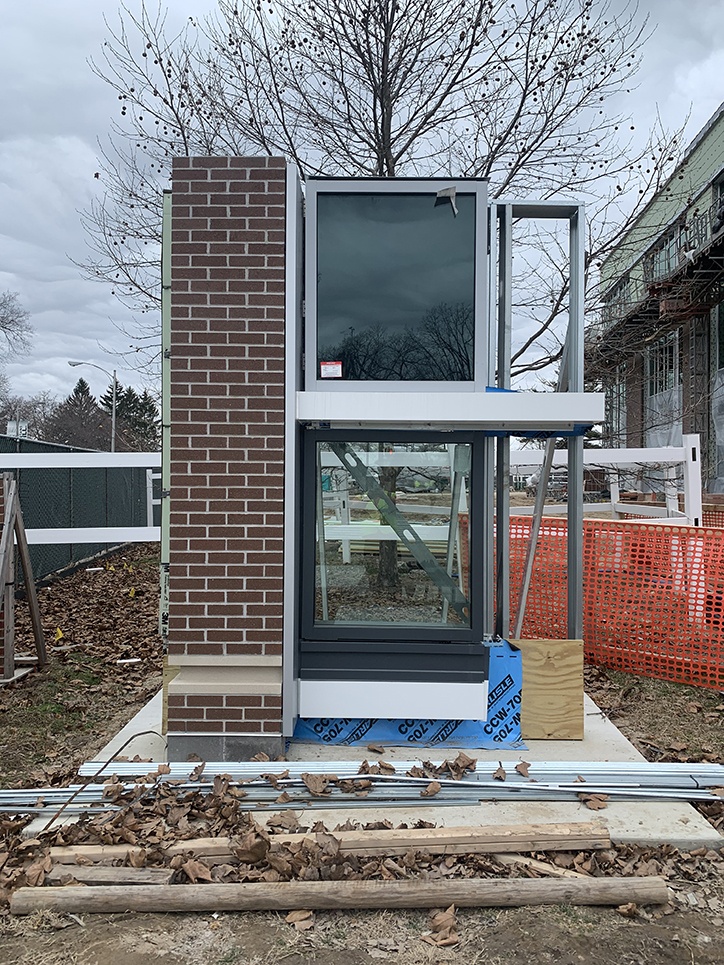
ROOTED IN EDUCATION
From day one, the Michigan State University STEM Teaching and Learning Facility and Shaw Lane Power Plant Renovation and Classroom Addition remained true to its ultimate mission of improving and enhancing learning experiences at Michigan State University (MSU). This included developing educational signage for students and campus visitors to enjoy and read when passing the jobsite. The team also hosted MSU classes studying related subjects like adaptive reuse. Whether organizing tours for Board of Trustees, State Agencies, Faculty, Staff, Students and Community Members or working with Economic Development and Environmental Conservation groups to create educational videos and presentations, the project team was committed to assisting MSU in sharing teachable moments.
PROJECT TEAM
Granger Construction is proud to have served as the Construction Management partner for this historic project. Other team members involved include the following:
Owner: Michigan State University
Owner Representatives:
- MSU Associate Provost for Teaching, Learning, and Technology
- MSU College of Agriculture and Natural Resources
- MSU College of Engineering
- MSU College of Natural Science
- MSU Infrastructure Planning and Facilities
- MSU Office of Planning and Budget
- MSU Facility Planning Space Management
Architects/Engineers:
Major Trade Partners:
- Architectural Metals
- Asbestos Abatement, Inc
- Building Controls Integrated
- Christman Constructors, Inc.
- Commercial Contracting
- Couturier Iron
- Detroit Spectrum Painters
- DC Byers
- Dobie Contracting
- Farnell Equipment
- Fessler Bowman
- Gunthorpe Plumbing
- Ideal Steel
- Kirby Steel
- Lansing Glass
- Nordic Structures
- Nicholson Foundations
- RAM Construction Services
- Bornor Restoration
- Schiffer Mason Contractors, Inc.
- Summit Contractors
- TCI Excavations
- Thyssen Krupp Elevators
- Total Fire Protection
- Waldner Equipment
- William Reichenbach Co.


